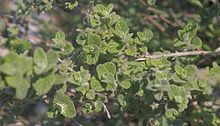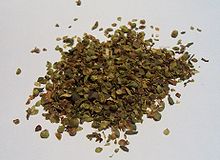 |
|
|
|
|
| Cuisines | Herbal | Spice | Curry | Yeast | Recipe | ||||||
|
Oregano Oregano (UK /ɒrɨˈɡɑːnoʊ/ or US /əˈrɛɡənoʊ/), scientifically named Origanum vulgare by Carolus Linnaeus, is a common species of Origanum, a genus of the mint family (Lamiaceae). It is native to warm-temperate western and southwestern Eurasia and the Mediterranean region. Oregano is a perennial herb, growing from 20–80 cm tall, with opposite leaves 1–4 cm long. Oregano will grow in a pH range between 6.0 (mildly acid) and 9.0 (strongly alkaline) with a preferred range between 6.0 and 8.0. The flowers are purple, 3–4 mm long, produced in erect spikes. It is sometimes called wild marjoram, and its close relative O. majorana is known as sweet marjoram. DescriptionOregano is a perennial growing to 20 inches, with pink flowers and spade-shaped, olive-green leaves. It prefers a hot, relatively dry climate, but will do well in other environments. To cultivate, it should be planted in early spring, in fairly dry soil, with full sun. The plants should be spaced 12 inches apart. Plant BiologyClosely related to the herb marjoram, oregano is also known as wild marjoram. Oregano is a perennial, although it is grown as an annual in colder climates, as it often does not survive the winter months. BiochemistryThe main chemical constituents include carvacrol, thymol, limonene, pinene, ocimene, and caryophyllene. The leaves and flowering stems are strongly antiseptic, antispasmodic, carminative, cholagogue, diaphoretic, emmenagogue, expectorant, stimulant, stomachic and mildly tonic. Culinary Uses Oregano is an important culinary herb, used for the flavor of its leaves, which can be more flavourful when dried than fresh. It has an aromatic, warm and slightly bitter taste, which can vary in intensity. Good quality oregano may be strong enough almost to numb the tongue, but the cultivars adapted to colder climates often have a lesser flavor. Factors such as climate, seasons and soil composition may affect the aromatic oils present, and this effect may be greater than the differences between the various species of plants. Oregano's most prominent modern use is as the staple herb of Italian-American cuisine. Its popularity in the US began when soldiers returning from World War II brought back with them a taste for the "pizza herb", which had probably been eaten in southern Italy for centuries. There, it is most frequently used with roasted, fried or grilled vegetables, meat and fish. Unlike most Italian herbs, oregano combines well with spicy foods, which are popular in southern Italy. It is less commonly used in the north of the country, as marjoram generally is preferred. The herb is also widely used in Turkish, Palestinian, Lebanese, Egyptian, Syrian, Greek, Portuguese, Spanish, Philippine and Latin American cuisines. In Turkish cuisine, oregano is mostly used for flavoring meat, especially for mutton and lamb. In barbecue and kebab restaurants, it can be usually found on table, together with paprika, salt and pepper. The leaves are most often used in Greece to add flavor to Greek salad, and is usually added to the lemon-olive oil sauce that accompanies many fish or meat barbecues and some casseroles. Oregano is also used by chefs in the southern Philippines to eliminate the odor of carabao or water buffalo when boiling it, while simultaneously imparting flavor. MedicinalHippocrates used oregano as an antiseptic, as well as a cure for stomach and respiratory ailments. A Cretan oregano (O. dictamnus) is still used today in Greece as a palliative for sore throat. Oregano is high in antioxidant activity, due to a high content of phenolic acids and flavonoids. It also has shown antimicrobial activity against strains of the food-borne pathogen Listeria monocytogenes. In 2005, the US Federal Trade Commission brought legal action against a firm that had claimed oil of oregano treated colds and flus, and that oil of oregano taken orally treated and relieved bacterial and viral infections and their symptoms, saying the representations were false or were not substantiated at the time the representations were made, and that they were therefore a deceptive practice and false advertisements. The final stipulation on the matter said no representation as to any health benefit could be made without "…competent and reliable scientific evidence…". |











